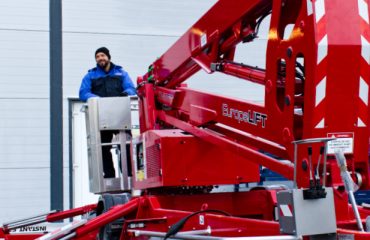
Falling while working at height is one of the most common causes of injury and death in Norwegian workplaces. Every year there are several serious accidents while working at height, many of which could have been avoided with increased awareness of the risks. Falls are one of the biggest hazards, and even falls from low heights can lead to serious injury or death. This can be due to poor maintenance of equipment such as ladders, scaffolding or work platforms, or failure to use personal protective equipment such as fall protection. Lack of attention or inadequate training are also common causes of fall accidents.
Weather conditions can also increase the risk of working at height, as slippery or wet surfaces can make it difficult to keep your balance, and strong gusts of wind can make working on high scaffolding dangerous. Employers must therefore carefully consider the weather conditions and ensure that work is carried out in a safe manner.
Safe work analysis and guide:
To counteract this, the Norwegian Labor Inspection Authority has launched a new guide for working at heights. The purpose of the guide is to ensure that employers carry out risk analyses themselves, instead of leaving this to employees using safe job analysis (SJA). SJAs are particularly common in the construction sector in Norway, but the Norwegian Labor Inspection Authority has observed that they are often carried out without it being clear who is to lead the work on behalf of the employer. When employees sign an SJA and an accident occurs, they are often held responsible.
You can find the guide here: The Norwegian Labor Inspection Authority’s guide for Working at Heights.
To reduce the risks of working at height, employers and employees need to work together to identify potential hazards and implement necessary safety measures. This can include thorough training of workers, regular maintenance of equipment, use of personal protective equipment and conducting risk assessments before work starts. It’s also important to have clear procedures for dealing with unforeseen incidents, such as having a contingency plan for falls and emergency telephones and first aid kits available in the workplace.
Training and proper equipment:
The main purpose of training is to provide participants with the necessary knowledge about the safe use, control, maintenance and disposal rules of various equipment used for work at height. Typical equipment used at height is scaffolding, ladders, work platforms, lifts and fall protection equipment. Instant offers a comprehensive range of online courses for the construction industry, including various work at height courses such as scaffolding courses (all heights), lift courses (A, B and C) and fall protection courses.
After completing the training, participants should be able to choose the right equipment and use this equipment in a responsible way. By being aware of the potential hazards, they will be able to create a safe workplace.
Communication and language challenges:
A lack of communication in the construction industry can also pose a significant safety risk. Especially when there are many foreign workers and companies involved. Workers from different countries may not speak each other’s languages or know each other’s cultures. This makes it particularly important that safety training is given in a language the workers understand. Instant has focused on language challenges in the industry and therefore offers most online course modules in several languages such as Norwegian, English, Polish, Lithuanian, Estonian and Romanian. The regulations have no direct requirements for Norwegian language skills, but training must be provided in a language the recipient understands. This means that many course participants who need important training can receive it in a language they understand via instantkurs.no.
*See a complete overview of the courses Instant offers here: course overview.
**You can read more about what the Norwegian Labor Inspection Authority writes about the use of lifts and the installation of scaffolding.




